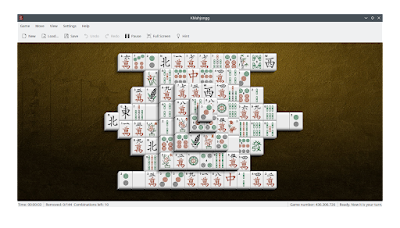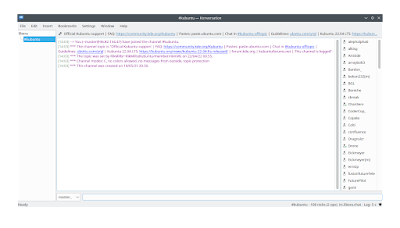Subscribe to UbuntuBuzz Telegram Channel to get article updates.
A
Ark
Ark is an archive manager program. The purpose is for compressing and decompressing archive files both compressed and not compressed, as well as both encrypted and unencrypted. It supports a lot of archive formats including ZIP, TAR, 7ZIP, RAR, CAB, and JAR. Thanks to its encryption features, it can password protect files in an archive file. It has a simple and easy to use user interface like any other KDE applications. It has a full documentation in the KDE Help Center.
B
-
C
-
D
Discover
Discover is the application store. It helps Kubuntu users discover, add, remove, and update applications as well as upgrade the whole system with graphical user interface that is easy to use. It is connected with https://apps.kde.org to help the users find & install more KDE Applications they want.
Dolphin
Dolphin is the file manager. Historically, it is the successor of the previous file manager, Konqueror. It is one of essential applications every Kubuntu user will use everyday. The purpose is to browse user's filesystem and directories both internally and externally. It shows the user's hard disk drive storages and USB flash drives as well as network storages in local area network and internet file servers.
E
Elisa
Elisa is the music player. Historically, it is the successor of the previous player, Amarok. Its purpose is to play audio files such as MP3, OGG, FLAC, WAV etc. Elisa is one of a few KDE Applications whose name not started with nor include 'K' letter.
Emoji Selector
G
Gwenview
I
Info Center
Info Center (KInfoCenter) is the center of detailed system information. Its purpose is to display computer hardware and software information such as CPU, RAM, GPU, networking, name and version of operating system etc. It is equal to My Computer's Properties on Microsoft Windows.
Input Method
Input Method (im-config) is the system configuration of typing input selections such as Chinese, Japanese, Korean (CJK) etc. For Kubuntu users working with CJK languages, im-config is essentially needed.
J
-
K
Kate
Kate is the text editor. Its purpose is to write plain text documents also known as TXT. It supports both simple use like writing notes as well as complex use like programming. It is equal to Notepad.
KCalc
KCalc is the calculator. It is also integrated in the KRunner (when the user presses Alt+F2). Its purpose is to calculate numbers. It features four different modes namely simple, science, statistics and numeral.
KDE
KInfoCenter
See Info Center.KDE Connect
KDE Connect is the smartphone-computer connector utility. Its purpose is to connect phone to computer via wifi. It is very useful as it enables both to transfer files between, remote input (touchscreen phone as mouse or keyboard), remote control, ringing, etc.
KDE Partition Manager
KDE Partition Manager is the disk management utility. Its purpose is to add, delete, resize, split and join disk storage. It is useful for editing hard disk, flash disk, SSD as well as other drives. It is equal to Windows' Disk Management and MacOS' Disk Utility.
KMahjongg
KMines
KMines is the mine sweeper game. User plays by guessing all the safe boxes and avoiding all the mines (bombs) boxes. The clue is that each number tells how many mines surrounding its box. It is equal to Minesweeper.
Konsole
Konsole is the terminal emulator. Its purpose is as a command interpreter for the user to control his/her computer quickly using command lines. It is very highly configurable through profiles and able to zoom text by hitting Ctrl+Scroll Mouse. It is equal to Command Prompt.
Konversation
KPatience
KPatience is the card games. User can plays several different card games. It features save and load game abilities. It is equal to both Freecell and Solitaire games.
KRDC
KDE Remote Desktop Client (KRDC) is the remote desktop utility. Its purpose is to graphically view and remotely controlling another computer(s) via network using RDP and VNC protocol. It is capable to remote another Kubuntu as well as Microsoft Windows and MacOS computers given that the target is running a compatible server. The user interacts by using keyboard and mouse as if the remote computer is in front of the user.
KSudoku
KSudoku is the sudoku game. User plays by guessing lines of numbers without in a way repeating already mentioned ones.
KSystemLog
KSystemLog is the system log viewer. Its purpose is to record, identify and help troubleshoot issues on Kubuntu system. The user can include the log as an information when asking support to Kubuntu community.
KTorrent
KWalletManager
LibreOffice Calc
Calc is the spreadsheet application of LibreOffice suite. Its purpose is to process numbers and data in table form with functions and formula and able to produce charts. It is equal to Microsoft Excel.
LibreOffice Draw
Draw is the vector drawing, diagram illustrator as well as PDF editor. Its purpose is to make brochures, flowcharts, free drawings, logos, pamphletes, posters, network diagrams and any other design possible. It is also able to edit PDF document in page by page fashion. It is equal to Microsoft Visio.
LibreOffice Impress
Impress is the presentation maker. Its purpose is to make beautiful and impressive slides (keynotes) for academic, business, technical and other fields. It is equal to Microsoft PowerPoint.
LibreOffice Math
Math is the equation editor. Its purpose is to write complex mathematics, physics, or chemistry equations in LibreOffice Writer. It offers pre-made equations can be filled later by the user. Alternatively, it accepts commands to write equations even quicker. It is equal to Microsoft Word Equation Editor.
LibreOffice Writer
Writer is the word processor. Its purpose is to process words. It can produce written documents such as articles, books, brochures, bulletins, letters, magazines, invitations, invoices, thesis etc. It is equal to Microsoft Word.
M
Muon Package Manager
Muon is the add and remove program utility. Its purpose is to help the user to find, add, remove, and update programs as well as upgrade the whole system on Kubuntu. Programs are available in a place in the internet called repository in form of packages in DEB format. It is equal to Debian's Synaptic Package Manager.
N
-
O
Okular
Okular is the PDF reader. Its purpose is to view and annotate electronic books in multiple format including PDF, EPUB, MOBI, CHM, and CBZ. It is singletabbed by default and multitabbed if needed.
P
Plasma
Plasma is the whole desktop environment of Kubuntu. Everything the user sees in the display is Plasma. This includes the panel, wallpaper, icons, clocks, widgets, and start menu (Application Launcher). In the past, KDE was the name of this desktop technology (Kubuntu name was originally made up from KDE + Ubuntu) but later it had been renamed as Plasma. This is the crucial difference to Microsoft Windows as Kubuntu does separate the system (GNU/Linux) and the desktop technology (Plasma) while Windows does not.
PulseAudio Volume Control
PulseAudio Volume Control (pavucontrol) is the sound configuration utility. Its purpose is to allow the user to set, adjust, switch and mix input and output of speaker and microphone.
Q
Qt
R
-
S
Skanlite
Skanlite is the scanner utility. Its purpose is to automatically detects connected scanner device and scan document into PDF or PNG format.
Spectacle
Spectacle is the screenshot utility. Historically, it is the successor to KSnapshot. Its purpose is to record picture of screen display. Among its main features are taking screenshots of whole or part of screen, a window, or either of them with a countdown. Like any other KDE application, Spectacle is also well-integrated to the desktop system. It is equal to Snipping Tool.
Startup Disk Creator
Creator is the bootable USB maker utility. Its purpose is to write in a way that ISO image file of an operating system, into a USB flash drive so that drive can boot the operating system on a computer. In other word, it is the utility to create a Windows, or GNU/Linux, or macOS bootable installer.
System Monitor
System Monitor is the resource utilization meter. Sometimes, utility like this is also called as task manager. Its purpose is to real-time show how-much and for-what CPU, RAM, and disk drive utilized in the system. It is equal to Task Manager.
System Settings
System Settings is the center of controls. Its purpose is like a control panel, providing easy ways of configuration for all things on the system. For instances, it allows the user to switch language, display resolution, and configure networking. It is equal to Control Panel.
T
TeXInfo
TeXInfo is the viewer of TeXInfo documents.
U
UXTerm
UXTerm is a Unicode-support version of the original X.Org's terminal emulator, XTerm.
V
VLC media player
VLC is the video player. Its purpose is to play audio and video. It is capable of playing any type of multimedia including MP3, MP4, 3GP, FLV, OGG, OGV, FLAC and WAV. It is also capable to convert and compress said multimedia files. It is equal to Windows Media Player.
X
XTerm
XTerm is the terminal emulator of the display technology, X.Org, in the Kubuntu Desktop.
Y
-
Z
-
See Also
A Complete Guide to Ubuntu GNOME Default Apps
A Complete Guide to Learn Ubuntu from Basics
This article is licensed under CC BY-SA 3.0.












































